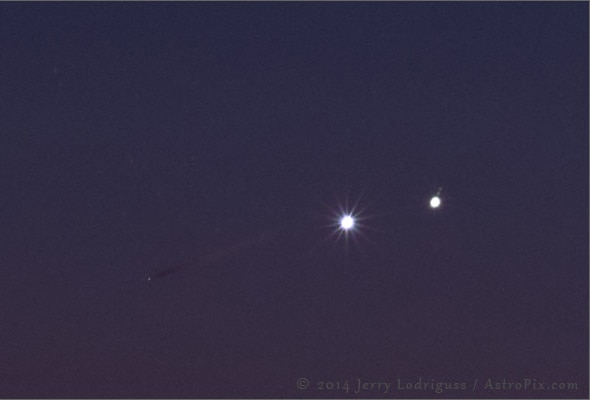Create a free profile to get unlimited access to exclusive videos, sweepstakes, and more!
Venus and Jupiter, Together

Over the past few mornings, the fourth and fifth brightest objects in the sky have been getting cozy. Venus and Jupiter are very close together just before sunrise, and have made for some lovely photo ops.
The planets orbit the Sun in roughly the same plane; if you looked at the solar system from the side it would look fairly flat. To us on Earth, in that plane, the planets all stick more-or-less to a line that circles the sky, which we call the ecliptic. It’s not perfect; some planets have orbits that are slightly tilted, so it’s not exactly beads on a string. But sometimes they do pass pretty close together, and it makes for a striking sight.
Jupiter is currently on the other side of the Sun from us, more than 900 million kilometers (almost 600 million miles) away. Venus is also on the other side of the Sun from us, but much closer: 240 million km (150 million miles) away. Jupiter is a far bigger planet, but Venus is closer and more reflective, so it appears the brighter of the two.
The photo at the top of this post is a part of a larger portrait of the pair as they appeared on the morning of Aug. 18, 2014. It was taken by Jerry Lodriguss in New Jersey, from a cranberry bog (which explains the light mist covering the ground). He also took the photo below:
You can see two moons of Jupiter (Io and Europa) just above it and to the right, as well as an airplane zooming by to the left. Make sure to take a look at a time exposure Lodriguss took of the two rising; they appear as long, colored streaks moving up from the horizon
Due to the complicated dance of orbits of the two planets (and our own Earth, changing the perspective on the pair), Venus is moving toward the Sun in the sky, rising later every morning, while Jupiter is slowly pulling away form the Sun, rising a bit earlier. The two are still close together for the next few days, so if you’re an early riser it’s worth getting up just before sunrise to look for them. Simply look east, but you’ll need a good view of the horizon; they’re not very high up.
Oh—so if they’re the 4th and 5th brightest objects in the sky, what are the first three? The Sun, of course, and the Moon … and No. 3 is the International Space Station, though to be fair it is only sometimes brighter than Venus. No matter; while the ISS is fun to watch, there is something about looking at a planet in the sky and knowing it’s an entire world, hanging there for us to see. It’s very much worth an early morning to catch a glimpse.


























